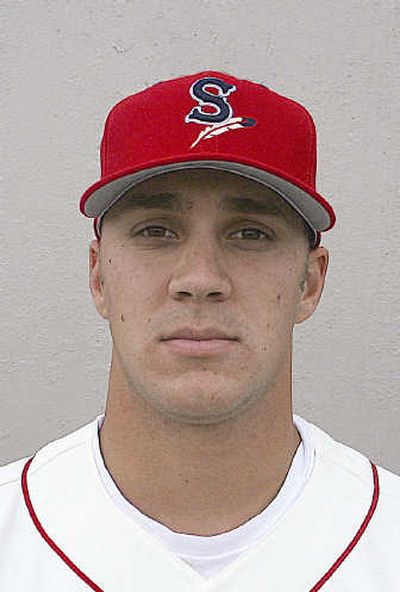Laughter making mark

He doesn’t jog to the mound, usually Andrew Laughter runs. Chin up, dark eyes narrowed, shoulders squared, with his glove tucked close to his chest as he takes his place in the center of the diamond amidst cheers from fans who, by this point in the season, know exactly what to expect from their closer.
Strikes.
Outs.
And saves.
A lot of them.
Laughter has been successful in 11 of his 13 save attempts this season, and stands fourth in the league in that category. In 31 innings, he’s thrown 32 strikeouts, allowed only seven earned runs and put up a 2.03 earned run average. He’s also the only reliever amongst the league’s five leading closers who has not allowed a home run.
That is because most batters can barely track his 94 mph power fastball, let alone hit it.
But Laughter wasn’t always this good. It took him a while to find his niche as a pitcher.
Laughter had a mediocre freshman year at Jacksonville University (Fla.), going 1-2 with a 8.06 ERA in 18 appearances and one start. His sopohmore year wasn’t much better: 4.96 ERA and a 0-2 record.
The following year, the Longwood, Fla. native transferred to Louisiana-Lafayette in search of a better baseball program. He spent his junior year getting used to his new surroundings and new team, and his ERA once again ballooned to 11.25. But then came senior year, a new roommate – his catcher Jonathan Lucroy, who now plays for the Helena Brewers in the Pioneer League – and a new mission: becoming a closer.
“There’s a big difference between a guy playing baseball and a baseball player,” said Louisiana-Lafayette baseball coach Tony Robichaux, “I think his junior year, he was a participator in college playing baseball.
“Senior year, he came back and became a difference maker wanting to pitch at the next level.”
The Ragin Cajuns’ coaching staff identified a personality trait in Laughter that would make him the perfect finisher: an unshakeable confidence in his ability to close out games.
Because that’s what Laughter does best. In his own words, he’s a sprinter. It’s all or nothing, all the time.
“I go right at people and throw strikes,” said the 6-foot-5-inch, 227-pound righthander, “I didn’t like the starting role because I don’t really know how to pace myself. I don’t like to pace myself. I go out there and just throw.”
And he’s the guy his team calls upon when they need someone to close out a tight game.
“He’s not gonna go out there and pitch scared,” said Lucroy, who caught for Laughter at Lousiana-Lafayette. “He’s a balls-to-the-wall-type of guy, and he’s always been like that. With runners on in the bottom of the ninth and the game on the line, he’s the guy I want on the mound.”
Maybe it’s because of his killer fastball and his ever-reliable slider. Maybe it’s because of his imposing physical stature – the way he possesses that mound, staring out at the batter from under the brim of his hat as he leans slightly over his front foot to watch for his catcher’s signals, glove resting casually on his left thigh, fingers wrapped snugly around the ball held against the small of his back.
Or maybe it’s simply because he radiates an ironclad confidence tangible to everyone around him.
Whatever it is, “he always seems to come out on top,” Indians third baseman Kenny Smith said after Laughter earned his eighth save of the season by closing out the Indians’ 5-4 win against Tri-City on August 15.
And what runs through Laughter’s mind when he takes the mound in those tight situations?
Just one thing: “It’s over.”
“I don’t doubt myself,” Laughter said. “I don’t allow negative thoughts in my head.”
But confident does not mean cocky. Laughter is not perfect, and he’s blown his fair share of saves.
“I blew one here,” he said, referring to the Indians’ 10-8 loss to Yakima at home in July. “We were up by one, with runners on second and third with nobody out. I gave up two runs.”
Yet despite being able to call up detailed memories of blown saves for review purposes, Laughter’s success as a closer is also contingent on his ability to forget past failures when he’s on the mound.
“A good closer has a very short memory, kind of like a field goal kicker in football,” Robichaux said. “If you miss a field goal in the first, you have to put it away or you won’t be able to make that kick in the fourth.
“With a closer, every time they have a bad outing, they don’t have time to come back. The game’s over.”
“The make up of a close is: you’ve got to be able to – good or bad – let the game go,” Indians pitching coaching Keith Comstock said. “You’ve got to attack the hitters and you’ve got to attack the strike zone.”
Laughter – who was drafted by the Texas Rangers with the 320th pick in the 10th round of the 2007 MLB draft – credits his football background with helping him develop his aggressive, attack-minded pitching style. Laughter was a three-year letter winner playing either tight end or wide receiver at Lake Brantley High School (Altamonte Springs, Fla.)
“That has a lot to do with my mentality,” he said. “I’m very aggressive. It really molded me into a strong competitor.”